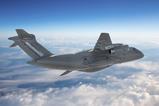The EuroDASS industry consortium responsible for the Eurofighter Typhoon’s Praetorian self-protection system has revealed its progress on expanding the capability, following recent flight trials.
Partner companies ELT Group (Italy), Hensoldt (Germany), Indra (Spain) and Leonardo (the UK) are conducting the work as part of an effort dubbed Typhoon Next Generation, along with systems integrator BAE Systems.
“The next-generation electronic warfare system will future-proof Typhoon against new and emerging threats through to 2060 and beyond, providing improved situational awareness and increased survivability,” EuroDASS says.
Substantial development work has already been completed, it says, via a ‘Praetorian eVolution’ concepting phase. Trials involving component parts such as “digital receiver and band-extension technologies” were conducted in 2023 using a flying testbed. That work was expanded earlier this year with test flights involving a Typhoon.

“As well as maturing the capabilities, the partners were able to gather substantial data on representative threat scenarios to support further development,” they say.
New features include “advanced complex threat characterisation, digital radio frequency memory capabilities and the provision of interfaces for an external, high-powered electronic attack pod for suppression of enemy air defence missions”, EuroDASS says.
Additionally, the new self-protection technology is being integrated with the Eurofighter’s new active electronically scanned array (AESA) radar systems, to provide “increased power for self-protection”.
The use of a “high-speed, high-bandwidth infrastructure to transmit raw signal data to an advanced central processing hub… will enable pilots to identify and prioritise multiple complex threats at once, and at greater ranges”, EuroDASS adds. “Typhoon will be more capable, more survivable, and more available.”
The in-development system also will employ what the consortium partners call cognitive electronic warfare techniques: the use of artificial intelligence and machine learning to “exploit the high-fidelity data captured and respond to new threats as they emerge”.
Another benefit of the updated system – which “will have no impact on the outer mould line of Typhoon and impose no restrictions on the current flight envelope” – will see it offered for integration with new-build aircraft and as a retrofit option.
The EuroDASS partners note that the current Praetorian system is already being upgraded separately as part of the four-nation Phase 4 Enhancement programme for the Eurofighter. That activity includes enhancing its integration with the platform’s new AESA radar variants.
FlightGlobal’s soon-to-be-published 2025 World Air Forces directory shows that there are more than 530 Eurofighters in operational service. In addition to partner nations Germany, Italy, Spain and the UK, the multirole type is also employed by the air forces of Austria, Kuwait, Oman, Qatar and Saudi Arabia.































